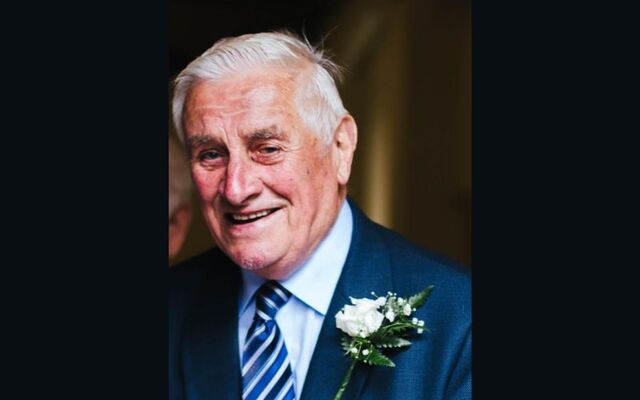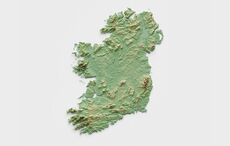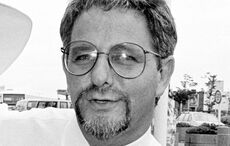Since leaving Rooskey, a small village on the Leitrim/Roscommon border, and moving to the US metropolis of Dallas, Texas, in 1991, Peter Farrell admits he has always wondered when that call might finally happen.
His fears were realized five years ago, on a Sunday at 10 am Dallas time. His sister-in-law, Bernie Farrell, rang in a distressed and panicked state and it took a few moments to get her calm enough to explain what was happening back in his home village more than 7,000km away.
It was his father Liam, she told him, something terrible had happened to him. He was lying on the ground and there was a lot of blood. Peter wanted to know one thing, was his father dead or alive?
"I don’t know," Bernie replied. "It must have been a heart attack. But Peter, something’s not right."
These words now regularly echo in his head. According to Peter, three of the people who saw his father that Sunday all made an identical observation.
"Bernie, my brother Brendan and my sister Ann, they said to me later that they all thought the same thing," he says.
"That it had been staged, that was their automatic reaction, that was their gut feeling."
Read more
The death of Liam Farrell, a popular and much-loved 87-year-old father-of-five, stunned the small community of Rooskey and beyond. Although elderly, he was a big strong man in rude health, who lived alone and still walked down to the village every day to do his errands. Once a week or so he enjoyed a few pints in his two local pubs.
The common perception in the area was that Liam had died of a heart attack, which ultimately he did. However, last September a jury at an inquest returned an open verdict, meaning they found the evidence did not fully or clearly explain the cause and circumstances of his death.
Peter and several members of his family had hoped for a verdict of unlawful killing. They are steadfast in their belief that Liam died as a result of being attacked.
Indeed, last week, to mark the fifth anniversary of their father’s death, they erected a black marble memorial stone in the front garden of their father’s house, with a photo of Liam and his dog Marley, boldly stating in gold-colored script exactly what they think happened to their dad. It makes for stark reading.
"On January 12, 2020, our beloved 87-year-old father Liam Farrell left the Weir Lodge Pub beside the pub in Rooskey to return to his home of 73 years, a mere 300m away," it reads.
"Upon his return, Liam was brutally attacked behind his home and in the hay shed, where he was tied up with a rope and severely beaten. He was subsequently dragged from the hay shed to the back door of the house, as we have been told, and evidenced by injuries to his body per the report of a forensic pathologist.
"Our father lay dying outside the back door in the coldest of winter conditions before finally passing away some 15 hours later.
"We believe our father was betrayed."
The family of 87-year-old Roosky farmer Liam Farrell, who was found dead in suspicious circumstances five years ago, unveiled a memorial plaque at his home this morning, which is appealing for public information. The unveiling took place on the fifth anniversary of his death. pic.twitter.com/GoQLfk9YPU
— Roscommon Herald (@RoscommonHerald) January 12, 2025
It ends by asking anyone with any information about the persons responsible for the attack, or responsible for "dragging and staging his body" to the back door, to call the Garda [Irish police] confidential hotline.
Peter says they thought long and hard about what to write, and that he has no doubt this is what happened to his father. He believes someone, who mistakenly thought Liam Farrell was "a man of means", attempted to ‘extort’ money out of him by brute force, but something went wrong.
He also believes the initial investigation into Liam’s death was flawed from the beginning, and the Gardaí’s initial conclusion that he suffered a heart attack at his front gate, banged his head off the ground, managed to crawl up to the back door of his house, a distance of about 20metre, then took off his socks, shoes and necktie, before lying back and dying, is nowhere near the truth.
He and his two brothers, Willie and Brendan, are determined to prove it. They got a boost last week when former RTÉ reporter turned MEP [Member of European Parliament] Ciaran Mullooly supported their calls for a fresh investigation into Liam’s death.
"While I understand a Garda review of the investigation is underway, I do not believe such an internal inquiry will bring any meaningful closure to the family,’ he said. ‘Their legitimate concerns must be addressed."
He questioned the original Garda investigation, and the conclusion it came to.
"I fully support the family’s call for a completely new investigation into this case," he stated.
"The possibility that this was a serious crime scene should have been treated with the utmost urgency from day one."
The family of the late Liam Farrell have been left with so many unanswered questions since his sudden death in the village of Rooskey county Leitrim 5 years ago. Today I join with Liam’s son Brendan in this public appeal for information on the circumstances of Liam’s death . pic.twitter.com/CcoNbSN0Q0
— Ciaran Mullooly MEP (@ciaranmullooly) January 11, 2025
"It was tough for him"
Liam and his wife Maureen Farrell had five children – Jim, Ann, Willie, Peter and Brendan, who range in age from 54 to 64. For 44 years, Liam worked on the production line of the Hanly pig factory, which has since closed. He also ran a small cattle farm out the back of the homestead.
While Jim moved to Donegal, Willie to North Carolina in the US and Peter to Dallas, Brendan stayed local, moving to a village about 13km away and Ann now lives in Longford with her own family. Maureen suffered with MS and Liam proved to be an attentive carer. Sadly she died in 2002 of cancer.
|Daddy was lonely, it was tough for him,| says Peter. |Then I started building my house next door and it kept him going.
|He’d be calling me and organizing a lot of the stuff, it gave him a lot of energy."
Once a week or so, Liam walked down to his local pubs. There are two near the bridge in Rooskey, The Weir Lodge and Reynolds, both are about six minutes away by foot from his house.
"He was a measured drinker, you’d never see him drunk," says Peter.
"I spoke to him on the Friday, the day before he died, he was in good form.
"The last time I’d seen him was the August, when I was home for a bit. We shook hands outside the back door, I got used to saying goodbye."
There are many questions the Farrell brothers still have about their father’s last night alive. For instance, the stranger who approached him in the Weir Lodge and spoke to him for some time before Liam left to go to the pub next door.
At the inquest, Ann Vaughan who works at the pub, told how this man was dressed in a dark suit, and she thought he may have followed Liam after he left.
"She also said that Daddy seemed uncomfortable," says Peter.
"Mystery"
After another couple of pints in Reynolds Pub, Liam walked home along the path.
He was seen by a local taxi man who was parked up at about 12.15am, and described him as looking in good form, with ‘not a bother on him’.
"What we know is that he did get to the front gate, but it’s kind of a mystery after that," says Peter.
"His keys were found at that gate and had blood on them."
There was also blood found on the gable wall of the house.
"We believe there was someone waiting for our father at the house," says Peter.
He believes his father’s attackers were possibly outsiders, brought in to rough Liam up and to "explain to him how it would be in his best interest to give over money".
"Someone was sent to my father, under the belief he was a man of means," he says.
"The truth of the matter was he was a simple farmer."
Certainly, Liam’s home is a basic bungalow. The family has kept it as it was, including not mowing the front lawn, in case of disturbing any evidence they hope might prove helpful in a new investigation.
In the large shed at the back of the house, Peter points out where a long blue rope used to hang and which he believes was used to tie his father up. A forensic investigations team they hired tested it with luminol to see if there was any sign of iron or hemoglobin, which are both found in blood.
Iron is also found in urine and rust. The rope, Peter says, immediately lit up and was subsequently turned over to Gardaí.
Another major concern are the photographs of their father’s body, which were released to them before the inquest, and are deeply distressing. There is obvious bruising to Liam’s face and caked blood. There are also injuries to his feet, which Peter believes show he was dragged from one location to another.
The autopsy on Liam’s body was carried out by a hospital pathologist, Prof Paul Hartel, who concluded he died of a heart attack related to severe coronary heart disease.
Inquest
At the inquest in September, however, Prof Hartel stated he was not informed that Liam’s body had been found in suspicious circumstances and that there was a crime scene. He said if he’d known, he would have refused to do the autopsy as it should have been "the duty of a forensic pathologist".
Chief state pathologist Dr Linda Mulligan reviewed the autopsy report following a request from the Gardaí. She told the inquest that she agreed with Prof Hartel that the ultimate medical cause of death was a heart attack.
However, she also said there were two possible scenarios for his death – that Liam suffered a heart attack and in a confused state fell, or there was another party involved that caused a stress-induced heart attack.
She said that due to the pattern of injuries, the involvement of another party could not be ruled out. She also said her office favored the first scenario, but that "you can’t say for certain". Peter’s sister Ann discovered Liam’s body.
"It was 3.30pm Irish time and when she walked to the back door, the first thing she noticed were Daddy’s feet," he says.
"She called her husband and Brendan first."
Brendan rang the emergency services and then his wife Bernie, who was second on the scene. She has said she noticed large footprints on the front lawn that "shouldn’t have been there".
Peter and Willie flew into Ireland the next day. Peter says none of them have had a chance yet to grieve for him. "We still can’t sit around and try to remember times we had with him," he says, his eyes filling with tears.
"We’ve never had that to this day. You don’t grieve because you have too many questions."
His questions include why the inquest jury was not shown the same photos that the family now have, of the extent of the injuries Liam suffered. Instead, he says, they had booklets of "fuzzy photos, where you couldn’t see anything properly".
He criticizes the inquest for not including testimony from the original superintendent who investigated the case, the coroner or the scene analyst, who have all since retired.
"The whole community wants justice"
After the initial Garda investigation, a file was submitted to the Director of Public Prosecutions and no prosecution was directed. But after September’s inquest, Garda Commissioner Drew Harris ordered a peer review of the original investigation.
It’s understood Commissioner Harris has asked that the Farrell family wait for the conclusion of that review, which is expected in the next few weeks before he meets with them.
Peter won’t divulge how much his family have spent so far on their own quest for answers about his father’s death, including the cost of hiring their own stenographer for the inquest.
None of them is wealthy, he says, but they’ll do whatever it takes, including selling Peter’s house in Rooskey, the one his father helped him to build.
"The Gardaí don’t have a monopoly on justice," says Peter.
"We as a family have an obligation to ensure that if anything of a criminal nature happened around the death of our father, that those persons are brought to justice.
"The whole community wants justice, it’s very hard on them too, no village in Ireland wants this hanging over them."
* This article was originally published on Extra.ie.




Comments